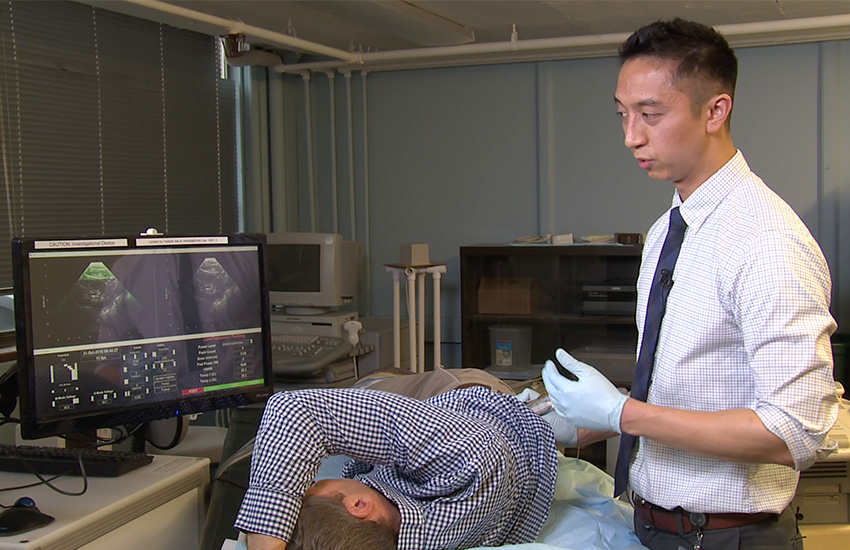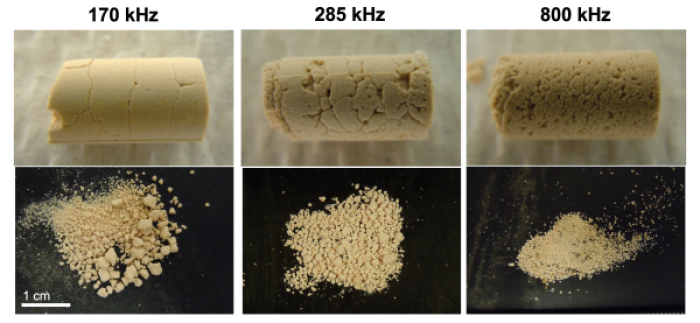UW engineers, including ME Professor Michael Bailey, have developed ultrasound technologies that break up and remove kidney stones.

ME Professor Michael Bailey and urology fellow Patrick Samson demonstrate ultrasonic propulsion, which moves stone fragments out of the kidney using lower-amplitude, longer-duration pulses while enabling the clinician to view real-time ultrasound imaging. Photo by the UW Applied Physics Laboratory
Kidney stones affect about 1 in 10 people, and can cause severe pain. A common way of breaking up kidney stones without surgery, called shock wave lithotripsy, typically requires anesthetics and large equipment. Fragments may remain in the kidney, requiring more treatments. Researchers across the UW — including in ME, the Applied Physics Laboratory (APL) and UW Medicine — have pioneered new treatments using ultrasound-based techniques to break up and remove stones more efficiently.
Bailey explains how the UW team started working in this area and how their technology is improving kidney stone treatment for humans and pets.
How did you start researching kidney stones and developing a new treatment?

Michael Bailey. Photo by the UW-APL
Our UW team has been part of a 30-year National Institutes of Health (NIH) grant to study how kidney stones are broken. We studied shock wave lithotripsy and recognized some its downsides, such as the need for anesthesia and additional treatments. About 15 years ago, with some NASA funding, we decided to make a better treatment from what we’d learned.
We tried a new approach, called burst wave lithotripsy, which uses lower-amplitude sound waves to break kidney stones. Simultaneously, we invented ultrasonic propulsion to sweep the stones out. Our group at the UW was the first to build that device. We engineered a handheld device, tested it to prove it was safe and effective, got FDA approval to do a study and showed success in a series of clinical trials. The technology is being commercialized by a company SonoMotion that spun out from the UW, and all our data are considered in regulatory review of any future products.
How does the ultrasound technology break and move kidney stones?

Applying different frequencies can control kidney stone fragment sizes during burst wave lithotripsy. Photo by Adam Maxwell/UW-APL.
Shock wave lithotripsy sends an acoustical impulse, while burst wave lithotripsy applies the same energy in a lower-amplitude, longer-duration tone burst. Burst wave lithotripsy amplifies the stress within the stone, stresses the stone repeatedly within each burst and applies more pulses per second. The locations in the stone are uniformly spaced and therefore create uniformly small fragments that pass with the urine.
With ultrasonic propulsion, we move stone fragments out of the kidney using pulses with even lower amplitude and longer duration. Both burst wave lithotripsy and ultrasonic propulsion use the same machine, which incorporates real-time ultrasound imaging to see the stones move and break. The machine features a handheld probe, which is used on awake patients who often pass the stone fragments themselves before leaving the clinic.
What have recent studies about these technologies found?
Our recent NIH-funded randomized controlled trial shows that ultrasonic propulsion offers clinical benefit for kidney stone patients by reducing the number of return visits to the ER or urologist. Reducing return visits could potentially lower health-care costs.
Our hope is that eventually, any provider can use burst wave lithotripsy and ultrasonic propulsion treatments — for both humans and animals. Initial results of a recent clinical trial with the University of Minnesota College of Veterinary Medicine on 10 cats with kidney stones show that burst wave lithotripsy could be a safe and effective alternative to surgery. We’ve also treated a dolphin and a seal.
Many people on our research team are engineers who want to build new medical devices, and we’ve done that. If you want to see the device you created work for people, it’s hard to imagine not being there through every step of the process, including clinical trials and commercialization.
Ultrasound technology cleared by FDA
This fall, the U.S. Food and Drug Administration (FDA) cleared a device developed at the UW and commercialized by SonoMotion. Stone Clear is the first and only device that uses external ultrasound pulses to sweep residual stone fragments out of the kidney without surgery and in the clinic setting.
Originally published November 4, 2024